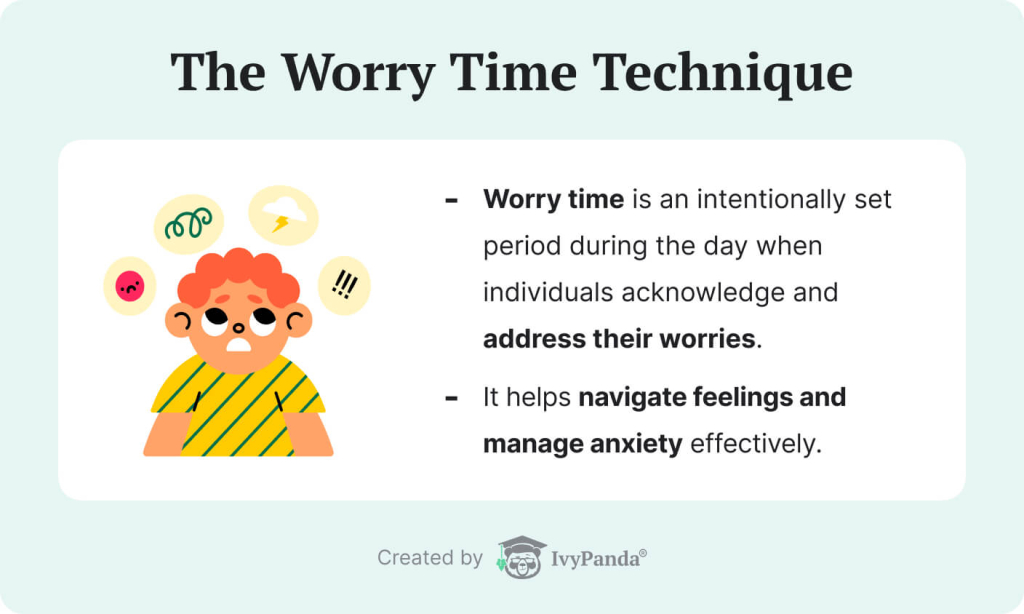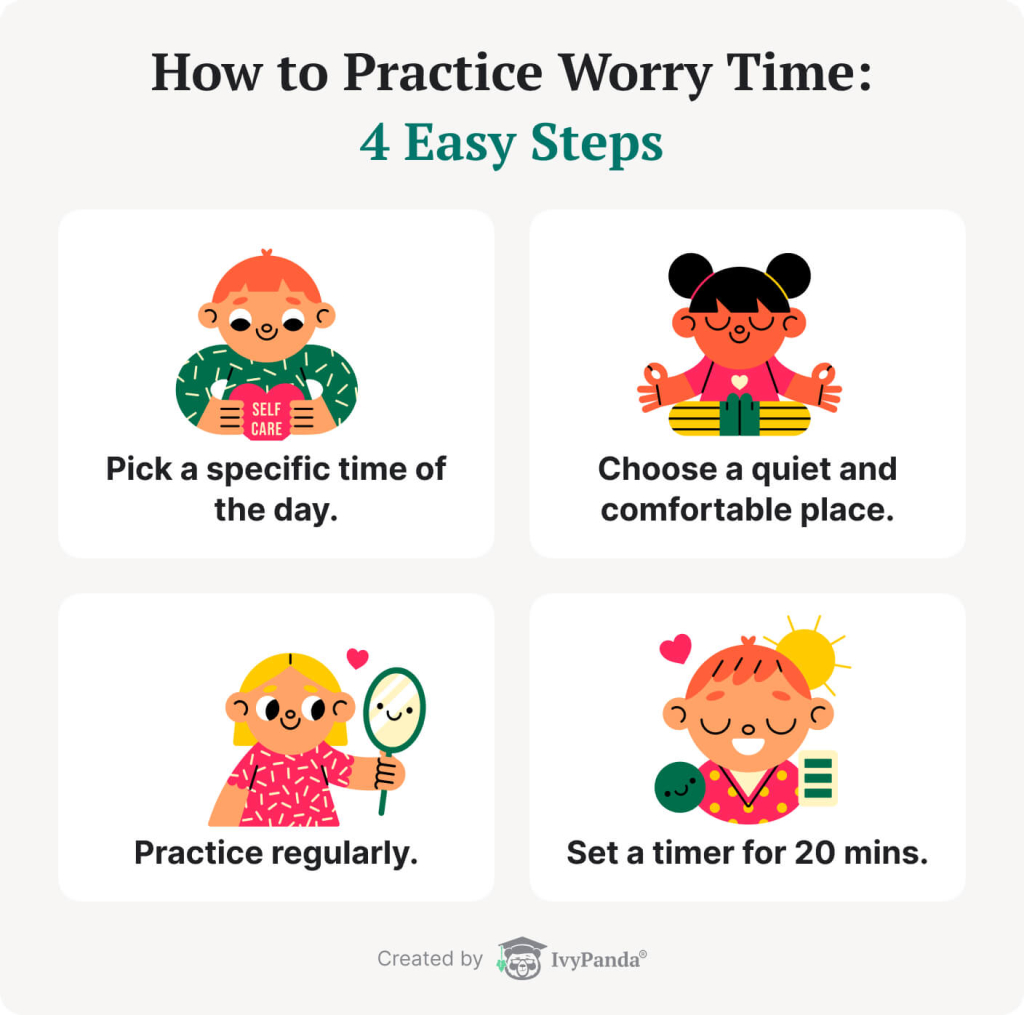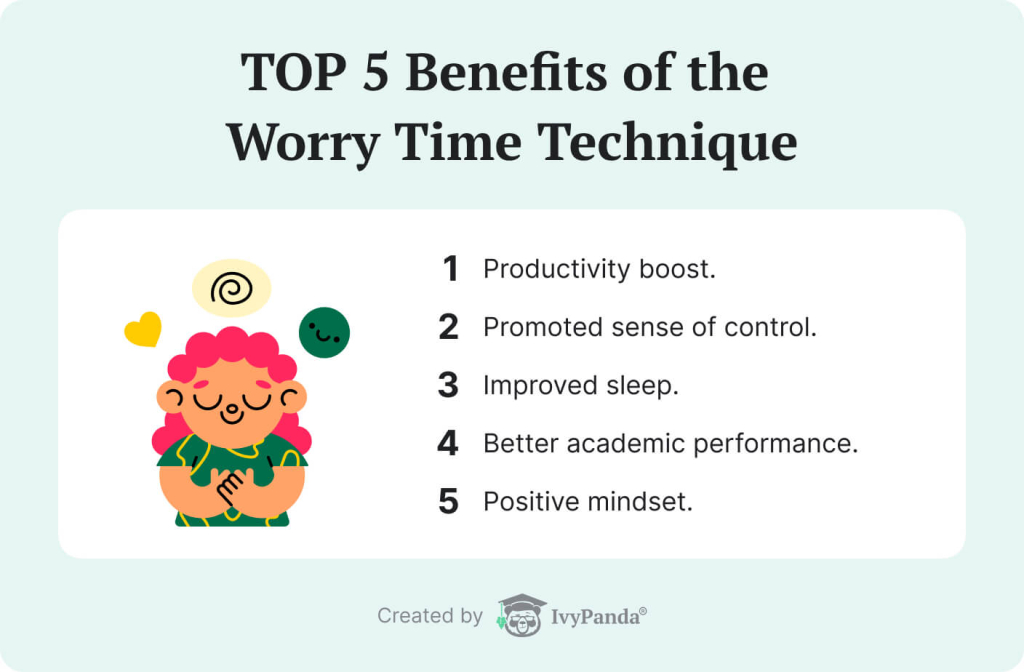Do you ever feel as though your worries are taking over your entire life? As a student, you might have a lot on your shoulders, and finding a balance between school, relationships, and your future can be problematic. However, what if there was a way to handle and reduce your anxiety?
This is where the concept of “worry time” comes in. The technique permits individuals to reserve the space to process their concerns and improve their well-being and productivity.

Below, we will discuss how scheduling time to worry can be of service to students and their mental health. If you’re ready to learn to control your concerns, keep reading.
⌚ What Is Worry Time?
Worry time is a technique that involves regularly setting aside time to address your anxieties and troubles. This approach is based on the assumption that some degree of stress is an inevitable and necessary part of life. However, if not managed effectively, it can interfere with daily function. Practicing worry time routinely will prevent your thoughts from spiraling and becoming overwhelming.
The term “worry time” was first described in a study by Borkovec, Wilkinson, Folsenbee & Lerman (1983). It was then later popularized by Dr. Robert Leahy, a clinical psychologist and author of the book “The Worry Cure: Seven Steps to Stop Worry from Stopping You.” Dr. Leahy described the “worry time” practice as a way to help individuals with anxiety disorders better regulate their concerns and reduce overall stress levels.
The purpose of “worry time” is not to completely do away with negative emotions but rather to create a designated time and space for worrying. This way, pessimistic thoughts won’t pursue you throughout your whole day. This technique might be distinctly effective for students, who often deal with high levels of stress and anxiety due to academic pressures and future uncertainties.

Worry Time Technique
The general guideline for the “worry time” practice is to allocate 15-20 minutes to sit down and intentionally contemplate on your worries or write them down. When choosing a place for worry time, it’s necessary to select a quiet and comfortable space, free from interruptions. This could be a designated corner in a bedroom or a cozy nook in a library. Once the time is up, you consciously release these worries and move on with your day. Practicing this technique regularly can establish a structured approach to managing stress and prevent your worries from becoming tedious.
🧐 10 Undeniable Advantages of Worry Time Technique
Many advantages make worry time an effective technique, for example:
- Enhances self-awareness and mindfulness. Setting aside time to focus on worries encourages you to exist in the moment and fully acknowledge your anxieties and emotions.
- Boosts productivity. By regularly scheduling worry time, you can free up mental space and energy to concentrate on responsibilities and tasks.
- Facilitates problem-solving. During worry time, you are incentivized to think about your concerns rationally and constructively, identifying possible resolutions.
- Promotes a sense of control. Rather than feeling swamped and consumed by your emotions, you can decide when to engage with them and for how long.
- Fosters a healthier coping mechanism. Worry time reduces the risk of picking up unhealthy habits such as excessive stressing or avoidance.
- Improves sleep. By practicing worry time during the day, you can release your negative thoughts before bedtime and enjoy better sleep.
- Creates a sense of structure. Worry time delivers a sense of routine, which can be beneficial if you struggle with anxieties. Having a designated time to focus on troubles can help create a sense of predictability and control in your daily life.
- Improves academic performance. By setting worry time, you can save energy to focus on studies and other academic tasks, leading to better outcomes.
- Encourages seeking support. Worry time can also serve as a time to reflect on whether additional aid is needed. This can motivate you to seek help from family, friends, or mental health consultants if necessary.
- Promotes a positive mindset. You can learn to reframe negative patterns and adopt a more positive attitude by actively engaging with anxieties during worry time.

📑 How to Use the Worry Time Technique
With the right approach, anyone can master the worry time technique and gain power over their anxiety. The initial and most crucial step is recognizing your needs and the specific results you hope to attain. These may involve reducing concerns and stress, enhancing sleep, or boosting productivity. Having a clear vision of the worry time purpose can motivate you to apply the technique in your routine consistently.
Here’s a guide on how to organize your worry time successfully:
- Choose a designated worry time and location. Select a particular time of day, like before bed or in the morning, and a quiet, secluded space where you won’t be interrupted. Schedule reminders to establish worry time as a regular part of your routine.
Read more about the importance of dedicating time for yourself here:
What Is Me Time & How to Spend It: Biggest Myths Busted + 60 Amazing Ideas - Set a timer for a maximum of 30 minutes. This will be the duration of your worry time. Adhering to this time limit prevents getting too immersed in your worries.
- Write down your worries. Use a notebook or journal to jot down your negative feelings on the paper. Be as specific and detailed as possible. This will help you to better understand and analyze your worries.
- Analyze your worries. Ask yourself, “Is this worry realistic?” or “Is there a solution to this problem?” This perspective allows you to determine which worries are worth addressing and which might be irrational.
- Set aside your worries until the next time. After your designated worry time is over, put away your notebook and try to let go of your worries until the next scheduled worry time.
- Plan activities to transition out of your worry time. Consider how you will move forward and prevent your stress from taking over. For example, if you have worry time in the evening, think about cooking a delicious meal or spending time with your family.
🌳 Worry Tree – A Tool for Structuring Your Worries
Worrying can be a productive and beneficial activity when approached in a controlled and structured manner. We’ve already discussed the worry time technique to help you with this, but there’s another visual tool: the worry tree.
A worry tree is a method frequently used in cognitive-behavioral therapy to help individuals understand the underlying causes of their worries and develop strategies to manage them. In this metaphor, the trunk symbolizes the primary source of worry, while the branches represent specific concerns or thoughts linked to that worry. You can find various worry tree templates available online to experiment with.
The advantage of using a worry tree is its ability to break down your worries into smaller, more manageable parts. It provides a set of questions designed to address your thoughts, each serving a distinct purpose in uncovering different aspects, causes, and potential solutions related to the worry.
Here are some questions from a worry tree with example answers:
- What is the specific worry I want to address?
This question helps you focus on a particular concern, making it easier to explore its various aspects.
Example: “The specific worry I want to address is my upcoming final exams.”
- What are the different factors and consequences connected to this worry?
By identifying the specific circumstances related to the worry, you can better understand the different dimensions it encompasses.
Example: “The main aspects connected to this worry are the vast amount of material to review, the pressure to perform well, my fear of forgetting important information during exams, and the potential impact on my overall grades and academic progress.”
- What might be the underlying causes or triggers that contribute to each aspect?
This question delves deeper into each branch to explore the background triggers.
Example: “I think what triggers this worry is the time management challenges I often experience and the importance I place on grades and academic performance.”
- What potential solutions or strategies can I generate to address each root cause?
This step promotes creative thinking and encourages you to think outside the box, exploring various possible approaches to alleviate the worry.
Example: “I will try creating a study schedule, asking my classmate Ann for help, and making sure to take regular breaks. Additionally, I might explore relaxation techniques to manage my stress during exams.”

☝️ Things to Consider about Worry Time
Worry time is not about wholly pushing a thought out of your mind but acknowledging it and intentionally choosing to address it at a more suitable time. When practicing worry time, make sure you don’t suppress your emotions, which can eventually exhibit in unhealthy ways. For instance, increased anxiety, depression, or other mental health issues.
For individuals with OCD (obsessive-compulsive disorder) or PTSD (post-traumatic stress disorder), worry time may not be suitable to manage and address their concerns effectively. It is also significant to note that worry time can trigger intense emotions in individuals who have a history of emotional or psychological abuse.
Remember that worry time is not a substitute for expert help and therapy. If you experience severe or persistent worries, you will benefit more from seeking support from a mental health professional. Therapy will give you the tools and skills to cope with your difficulties healthily and sustainably.
😵 How to Worry Less as a Student
Student years are exciting, offering many opportunities for growth and new experiences. However, they can come with stress and worries. The transition to a new academic environment, increased workload, expectations, exams, and balancing various responsibilities can become daunting.
While worry time is one strategy to manage worries, there are several more useful methods that we recommend trying:
- Prioritize and categorize your obligations. Make to-do lists and classify your tasks based on their urgency and deadlines.
- Break down big projects into smaller ones. Instead of confronting an extensive assignment or chore all at once, break it down into more manageable parts.
- Work on your time management. Determine specific blocks of time for studying, completing assignments, and relaxation.
- Take breaks. Ensuring to rest throughout the day helps recharge and prevent emotional burnout.
- Get enough sleep. Make sure to have enough rest each night to help you stay focused and energized during the day.
- Practice self-care. Set aside time for activities that help you relax, such as exercising, reading, or socializing with friends.
- Seek support. Don’t hesitate to contact family, friends, or an academic counselor if you’re feeling overwhelmed or stressed. Sharing your worries can help you gain a fresh insight and find creative solutions.
- Avoid comparing yourself to others. It’s easy to get caught up in comparisons, especially in a competitive academic space. Remember, everyone has unique strengths and weaknesses. Focus on your progress and personal achievements.
- Don’t be afraid to say no. If you feel overwhelmed, saying no to social events or extra commitments is okay. Prioritize your well-being, and don’t feel guilty for setting boundaries.
- Take care of your physical health. Eating a balanced diet, keeping hydrated, and exercising can reduce anxiety and improve overall well-being.
- Practice technological detox. Constantly checking social media and emails can add to your stress levels without you noticing it.
- Reward yourself. Don’t forget to reward yourself for your hard work and accomplishments, no matter how small they may seem.
Worrying is a natural part of life, but with the worry time technique, we can learn to manage it and not let it control us. Setting aside time to focus on your worries can prevent these thoughts from consuming your entire day and hindering your productivity. With practice and determination, you can use worry time to improve your mental well-being and overall academic performance.
As the saying goes, “Worrying does not take away tomorrow’s troubles. It takes away today’s peace.”
🔗 References
- How to Manage Anxiety – University of Houston
- Worry Time: The Benefits of Scheduling Time to Stress
- Stressed Out? Put It On the Calendar
- A Simple but Effective Trick to Stop Worrying So Much | Psychology Today
- Anxiety in college: What we know and how to cope – Harvard Health
- Survey: stress is hurting college students
- Managing and treating anxiety – Better Health Channel



